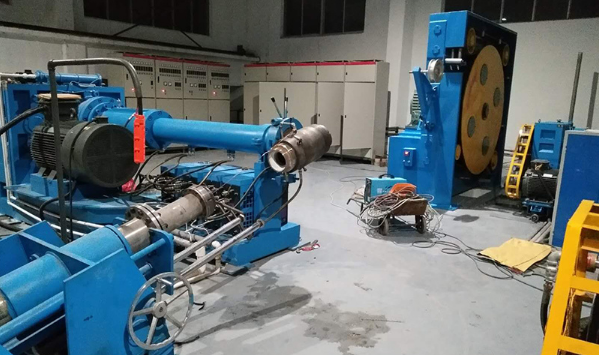Cable Production Line
2025-05-14 15:12

Next comes the extrusion process. In this stage, a special polymer material, often a type of plastic like polyethylene or polyvinyl chloride (PVC), is melted and extruded around the conductive core. The extrusion machinery is highly sophisticated, with precise temperature control and pressure regulation. This ensures that the insulating layer is evenly and smoothly formed around the wire. The thickness and quality of the insulation are critical factors in determining the cable's performance and safety. For example, in power cables, a proper insulation layer is essential to prevent electrical leakage and short - circuits.
After the extrusion of the insulation, the cable may go through additional processes depending on its type. For some cables, a shielding layer is added. This can be made of materials like metal foil or braided wire. The shielding layer serves to protect the cable from external electromagnetic interference. It is especially important in cables used for data transmission, such as Ethernet cables, where interference can cause data loss or corruption.
The cable production line also includes a jacketing process. A protective outer jacket is applied to the cable. This jacket not only provides physical protection against abrasion, moisture, and other environmental factors but also can be color - coded for easy identification of different cable types. The jacket material is selected based on the specific requirements of the cable's application. For example, cables used outdoors may require a more durable and weather - resistant jacket.
Quality control is an integral part of the cable production line. Advanced sensors and inspection devices are installed at various points along the line. These can detect any irregularities in the cable's diameter, thickness of layers, or presence of defects in the materials. Any sub - standard products are immediately identified and removed from the production process, ensuring that only high - quality cables reach the market.
The production line is designed for high - speed and continuous operation. It can produce cables in different lengths and specifications according to customer requirements. With the development of technology, modern cable production lines are also becoming more energy - efficient and environmentally friendly. They are capable of reducing waste and emissions during the production process, while still maintaining high - production capacity.
In summary, a cable production line is a comprehensive and essential system for the production of reliable and high - quality cables. It combines advanced technology, precise engineering, and strict quality control to meet the diverse needs of industries such as telecommunications, power generation, and electronics.
Cable Production Line
recommend reading
How to Optimize Your Cable Production Line with Plastic Extrusion
How to Optimize Your Cable Production Line with Plastic Extrusion In the ever-evolving landscape of the electrical cable industry, optimizing production lines is crucial for maintaining efficiency and competitiveness. **Plastic extrusion** stands out as a transformative process that can significantly enhance production capabilities. In this article, we will explore the intricacies of plastic extru
Understanding Wire and Cable Extrusion Production Lines: A Comprehensive Guide
In the electrical and electronics industry, the production of wires and cables is a fundamental process that ensures the efficient transmission of electricity and data. A wire and cable extrusion production line is a specialized setup designed to manufacture cables by extruding materials into specific shapes and sizes. This process is crucial for producing various types of electrical cables, inclu
Innovative Solutions: Cold Feed Rubber Extruder Technology in Today's Industry
Innovative Solutions: Cold Feed Rubber Extruder Technology in Today's Industry Table of Contents 1. Introduction to Cold Feed Rubber Extruder Technology 2. Understanding the Mechanisms of Cold Feed Extrusion 3. Benefits of Cold Feed Rubber Extruder Technology 3.1 Enhanced Product Quality 3.2 Increased Production Efficiency 3.3 Cost-Effectiveness 4. Applications of Cold Feed Rubber Extruders in the
Understanding Rubber Extruders: A Key Component in Electrical Wire and Cable Manufacturing
Rubber extruders are essential machinery in the electrical wire and cable manufacturing sector, playing a pivotal role in shaping the performance and quality of electrical products. These specialized machines are designed to process rubber compounds, transforming them into various shapes, primarily for insulation and jacketing of wires and cables. Understanding how rubber extruders operate and the
How to Implement Sustainability in Cable Production Line Practices: A Comprehensive Guide
How to Implement Sustainability in Cable Production Line Practices Table of Contents Understanding Sustainability in Cable Production The Importance of Sustainability in the Cable Industry Current Challenges in Cable Production Strategies for Sustainable Cable Manufacturing Energy-Efficient Production Techniques Recycling and Materials Management Technological Advancem
Understanding the Role of Plastic Extruders in Electrical Wire and Cable Manufacturing
Plastic extruders play a crucial role in the electrical wire and cable manufacturing industry, especially in the production of insulated wires and cables. By understanding the functionalities and benefits of plastic extruders, manufacturers can enhance their production processes, optimize material usage, and improve overall product quality. At its core, a plastic extruder is a machine that melts p




